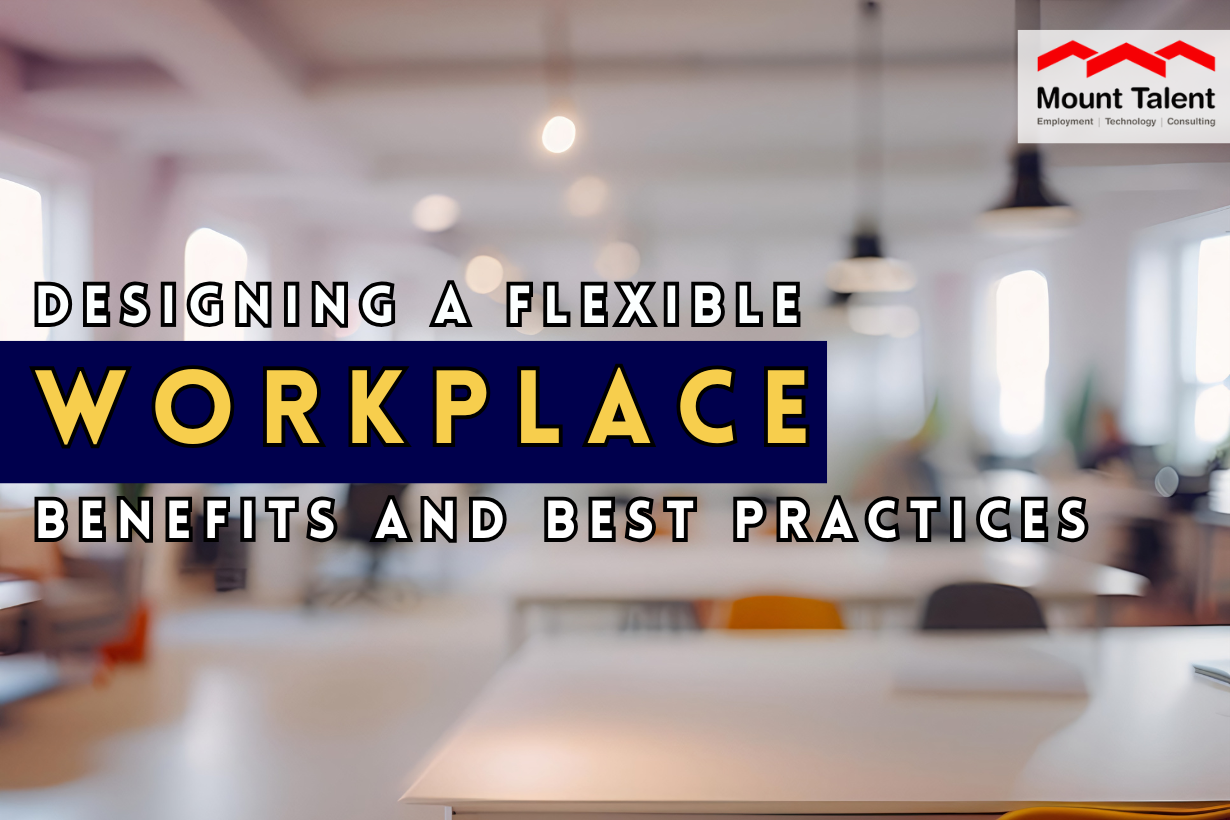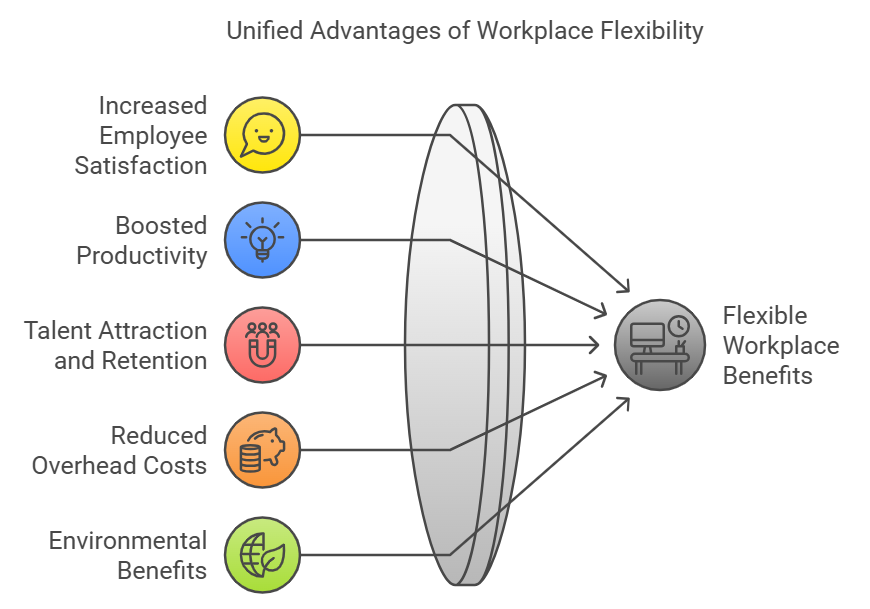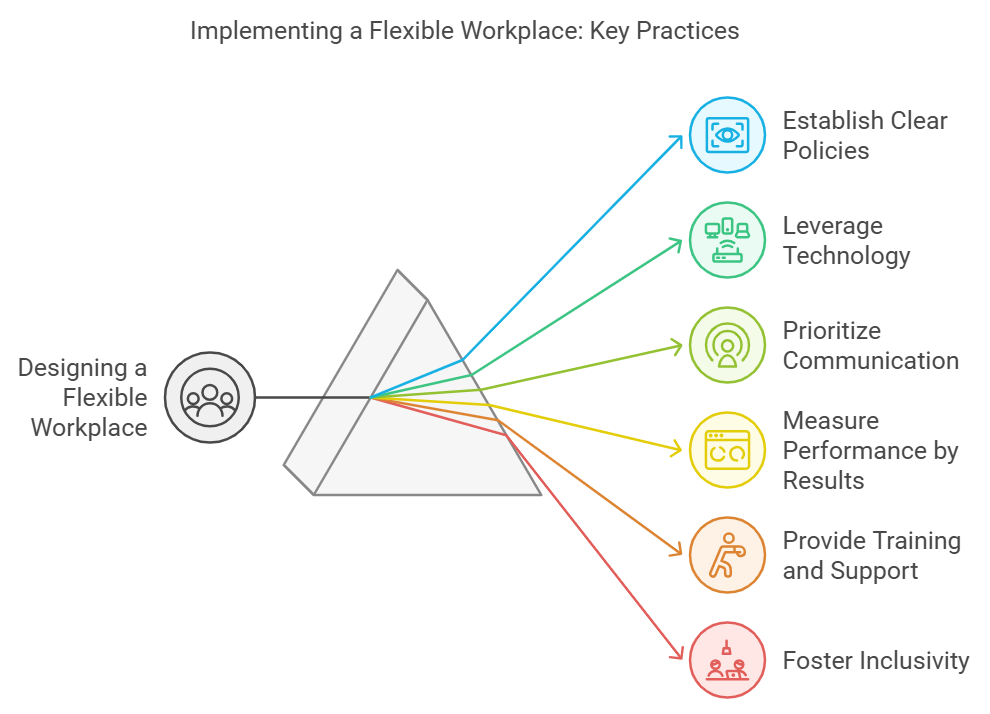
Designing a Flexible Workplace: Benefits and Best Practices
- by Mayank Thapa
The modern workforce is witnessing a shift in the working model or working culture in which work is done and how. The popularity of using work flexibility as a way of achieving a balance between work and family life together with the developments in technology have put the option of flexible work arrangements at the heart of organizations’ success. But what did get some meaning in the context of a flexible workplace? In what ways can the employers and employees of the modern workplace realize the improvements resulting from the flexible workplace arrangements implemented? Understanding a flexible workplace. In this article, we provide meaning to the term flexible workplace, its benefits, and some special techniques to adopt flexible working.
Understanding the Flexible Workplace Meaning
In its simplest form, a flexible workplace is a provision of work options in the organization that meet a range of employees’ temporal, spatial, and organizational demands. While most organizations are fixed in nature with regard to timing, location, and method of work, the freedom of a flexible workplace means employees can work at any time, in any place, and in any manner to achieve the intended goals and perform as desired.
Key Elements of a Flexible Workplace:
- Flexible Hours: Employees can begin and end operations at a time convenient to them.
- Remote Work Options: The flexibility of workplaces means that the employees can work at places other than the main business premises.
- Job Sharing: This means whereby two or more employees work in the same job where one employee would normally work.
- Compressed Workweeks: Employees work the same number of hours in a few days of the week.
- Output-Focused Performance: Performance is determined by outcome not time spent on the task.
As this paper has also shown, through the use of flexible workplace arrangements, organizations can design places of work that address outcome-oriented production and at the same time accommodate different needs of the workforce.
Benefits of a Flexible Workplace
The implementation of a flexible workplace is a notion that provides many advantages to the employer and the employee. These benefits cut across functionality, employee satisfaction, cost, and many others.

1. Increased Employee Satisfaction
In general, self-scheduling is a positive management strategy to enhance job satisfaction among employees because of the independence, flexibility, and control over their working environment. A flexible working environment increases satisfaction rates, work-to-life adjustment, and dedication to the company.
2. Boosted Productivity
People who work from a flexible workplace have better productivity due to less interference and they get to work in their most productive hours. Some of the research suggested that flexibility increases overall productivity and creativity among employees.
3. Talent Attraction and Retention
In today’s job market, flexibility at work is among the strongest incentives for employees. For most working professionals flexibility has become a crucial factor, especially in selecting their employers, hence the need for companies to contend with.
4. Reduced Overhead Costs
Many employers continue to allow ad hoc work-from-home arrangements or schedule their workers in shifts, to conserve office space and associated costs, such as utilities, and transportation. In fact, a flexible workplace is not only a boon for the employee but is also very much possible to implement.
5. Environmental Benefits
The energy of travel and office space is thereby saved by effective working arrangements, therefore promoting sustainability as part of company goals.
Best Practices for Designing a Flexible Workplace
To develop an effective flexible workplace there must be good planning, communication, and a good technology system in place. Here are the best practices businesses can follow to implement flexibility successfully:

1. Establish Clear Policies
Establish the meaning of flexibility for your organization. Key aspects that should be clearly articulated in policy include the kinds of flexibility at the workplace, qualification for flexibility, and productivity standards. Since then, specific rules have helped avoid situations where some company members are treated unfairly compared to others and guarantee objective decision-making.
2. Leverage Technology
Getting the right tools for your team to use while they’re working remotely will help your business thrive. Tools such as video telephony, collaboration project management tools, file sharing, and storage systems enable a flexible workplace as a primary communication and collaboration tool.
3. Prioritize Communication
This is very crucial in providing frequency in interaction so that everyone in the organization is on the same page. Since everyone will be working remotely or virtually, create spaces for feedback and updates, and for the team to interact as a whole.
4. Measure Performance by Results
Consider the results instead of the number of hours one spends in the office. Such an approach makes certain that flexibility does not affect productivity, and the employees will always excel in the ways that they want to work.
5. Provide Training and Support
Educative managing staff and employees on the benefits and expectations that they are going to experience flexibility at the workplace. Discuss issues to do with such measures as professionalism, accountability, teamwork as well as trust in order to forge a work culture that will allow for flexibility.
6. Foster Inclusivity
Offer choice arrangements for work design that would accommodate employees’ different needs such as parental care or disability. As much as flexible work is designed to accommodate family responsibilities among the workers, it also needs to accommodate any other circumstance that the workers find useful to make the company a better place to work.
Challenges of Implementing a Flexible Workplace
Undoubtedly, the flexible workplace is rather persuasive, though, the arrangements of such appear to be the difficulties faced by organizations. These challenges should be identified and managed if long-term success is aimed.
1. Trust and Accountability
There may be some problems with trusting employees in case they waste time out of the office. Lack of clarity and standards come in the way of trust, and at the same time even in the interest of the clients, clear terms leave no room for ambiguous actions and obscurity of work that has been done.
2. Team Collaboration
It becomes a challenge to keep the collaboration in a flexible workplace especially when dealing with a remote workforce. This is a manageable challenge, however, if a culture for regular virtual check-in is created then this becomes easily manageable.
3. Technology Dependence
Flexible workplace = technology dependent. There is a need for organizations to provide means for their agents to seek assistance that would minimize disruption of work output.
4. Employee Overwork
Having blurred lines between the function and the region can create burnout. Empower employees to set personal professional reference pointers at times when off the job, and offer help for their psychological health.
Real-Life Examples of Flexible Workplace Success
Organizations with flexible workplace arrangements and policies have been established; flexibility has provided impressive benefits. Other big organizations such as Google and Microsoft besides Salesforce have been using flexible policies so as to show that productivity and flexibility are inseparable. They focus on performance and productivity and offer the workforce the support and authority that equity requires of a fluid work environment.
The Future of Flexible Workplaces
Flexible work is not a new concept anymore, but it has become a new norm. With technology and the expectations of the employee rising in the future the meaning of the flexible workplace will be even more diverse with new arrangements. Many organizations that make flexibility its core value and which adapt to these changes shall place themselves to become strategic future organizations.
In order to effectively compete, flexible workplace arrangements should be seen by organizations as a way of investing in its human capital. The flexibility policy orientation of organizations shows that the welfare of employees and the efficiency of organizations are highly valued.
Conclusion
Thus, creating flexibility at the workplace has become imperative or is the survival kit for those organizations that desire to survive in the ever-changing working environment. To achieve the organizational goal of flexibility at work, appropriate changes should be made to flexible workplace arrangements to improve both output and staff relations. For more information on organizational flexibility and other creative HR strategies, please follow the link mounttalent.com. Our professional tips and resources guide you toward creating an environment that supports employees and delivers value.
Frequently Asked Questions
- What is flexibility in the workplace?
Answer- A flexible workplace is the ability of an employee to decide when, where, and how he or she performs his or her duties in order to accomplish the intended objectives.
- What are flexible workplace arrangements?
Answer- Other examples of FWA are working from home, working for different hours within a week, sharing jobs, and some other arrangements, that will help everyone.
- How can a flexible workplace benefit employees?
Answer- Different reports and papers have shown that there are positive impacts on the employees resulting from flexible working arrangements for instance improved work-life balance besides minimum stress levels as well as improved job satisfaction.
- What are the barriers to implementing a flexible workplace?
Answer- Some of the issues include; building and sustaining trust, cooperation, and collaboration within the team, guaranteeing that the relevant technologies used are reliable, and engaging and avoiding burnout of the employees.
- How can organizations create a successful flexible workplace?
Answer- Therefore, there is a need for organizations to implement a formal policy and use technologies to support work scheduling, couple outcome-oriented approaches with flexibility, and encourage workers to engage in an open discussion about flexibility.
The modern workforce is witnessing a shift in the working model or working culture in which work is done and…
